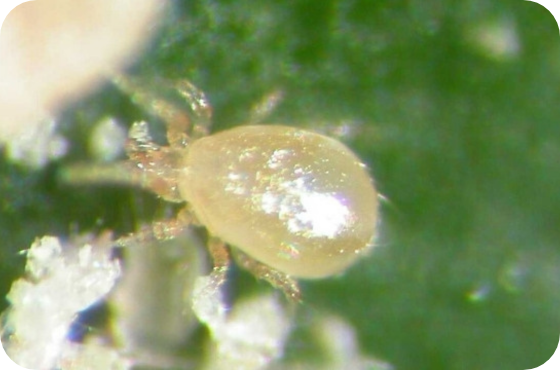Quality Products
Fast Delivery
Premium Service
Written by Kevin van Kester | Last update: 26. November 2020
The predatory mite Amblyseius cucumeris is an effective natural enemy of various types of thrips in vegetable and ornamental crops. Since it also consumes pollen and anther dust, this mite is frequently deployed as a preventative measure in crop protection.

Amblyseius cucumeris is extremely active and hungry, this mite searches plants thoroughly to locate its prey, mainly focusing on the first larval stage of thrips, but it also consumes spider mites. In addition to these pests, cucumeris consumes pollen and anther dust, allowing it to survive even when prey is scarce. This unique ability to thrive without prey is why cucumeris is commonly used as a preventative measure in pest management.
Cucumeris mites are identifiable by their light pink to reddish-brown or sometimes yellowish colour. Due to their tiny size of about 0.5 mm, these mites are hard to spot without magnification. Their short life cycle allows them to multiply rapidly, quickly growing into a large population.
Cucumeris mites are effective against several pests, including:
Cucumeris predatory mites are at their best at temperatures around 25°C, but they are already active from 15°C. However, temperatures exceeding 33°C are detrimental, as the mites struggle to survive and will seek cooler, more humid spots within the plant’s axils to stay alive.
Royal Brinkman Canada offers a specialized range of Amblyseius cucumeris predatory mites for reliable thrips control.
Cucumeris comes in two convenient formats:
These contain tens to hundreds of thousands of predatory mites mixed with a carrier, making it easy to distribute them across your crop. You can either sprinkle the contents directly or use a blower for even coverage. Make sure to shake the tube or bag thoroughly before use to ensure the mites are well-mixed. Continue mixing the material during application and shake it evenly over the plants. For areas with higher pest activity, apply more mites. Repeat the application every two to four weeks based on pest levels.
Each grow bag holds about 1,000 predatory mites and can be hung among your plants using hooks. Place the bags between the leaves for optimal results and be mindful of sunlight, as exposure can reduce the effectiveness of the mites.
For optimal effectiveness, release cucumeris mites into your crop as soon as possible after receiving them. If immediate application isn’t feasible, store the mites briefly in a cool, dark place. Ensure that the boxes are spaced apart to allow proper ventilation through the openings.